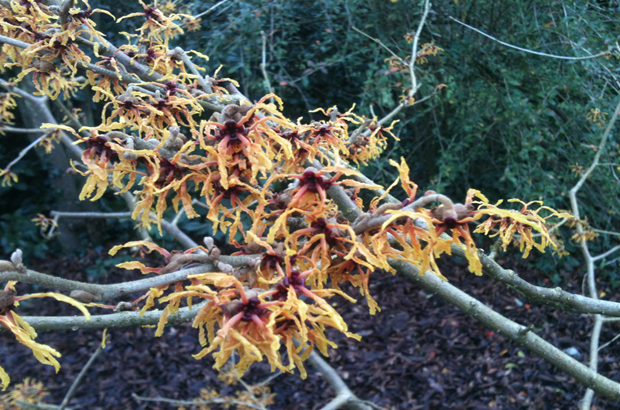As with most plants, you always find an article somewhere sighting it as a ‘must have’ plant. So why ‘must you have’ Hamamelis, or witch hazel as it is commonly known?
According to the RHS ‘Its spicy fragrance and spidery flowers in yellow, orange and reds make it a must for the winter garden.’
Hmm…..sounds tempting already I suppose! After all, our winter gardens can be a mire of plant death and leaf decay with some slippery paths and hard cut back, uninteresting borders. The idea of a whiff of a spicy fragrance in the air may, at the very least, encourage us to venture out for five minutes on crisp, sunny winter’s morning. And the sight of its spidery flowers, in a variety of autumnal colours with some early spring bulbs determinedly pushing out of the hard ground at their feet, may make us stand at the window and enjoy our warming cuppa while pondering the vision of life in the otherwise sleeping garden.
Hamamelis virginiana was first introduced back sometime in the 1600/1700s by a chap called Peter Collison. H. virginiana (can you guess where it came from?!) is the one we know of as the skin treatment for spots and acne. Since then, a variety of others have been introduced from various continents. H. mollis is one of the most popular as it flowers on bare stems, with many cultivars being derived from H x intermedia – a hybrid of H. mollis and H. japonica (don’t you just love their names…totally gives away their origins!).
H. intermedia ‘Barmstetd Gold’
Yellow varieties include: H. x virginiana, H. x intermedia ‘Pallida’, H. mollis ‘Wisley Supreme’, H. x intermedia ‘Barmstetd Gold’
Orange/bronze varieties include: H. x intermedia ‘Jelena’, H. x intermedia ‘Orange Peel’, H. x intermedia ‘Aphrodite’
Red varieties include: H. x intermedia ‘Diane’, H. x intermedia ‘Livia’
H. x intermedia ‘Aphrodite’
So what do you need out there to successfully grow one of these ‘must have’ shrubs?
Well, thankfully, they are able to grow in more places than you probably thought, with a little help. They do prefer acidic-alkaline soils (pH 4.5-6.5), but will also grow in deep soils over chalk so long as plenty of organic matter is incorporated into the soil.
Heavy clay will also need some incorporation of organic matter as Hamamalis does require a free draining soil (while at the same time needing a good supply of moisture!). Mulch in the autumn to conserve water at the base of the plant.
Plant in the open in the sun, but you will find they can tolerate part shade. Full shade will encourage straggly growth and will result in a weak looking specimen. Plant in sheltered positions.
As for maintaining the shape, simply prune out the dead, diseased and dying stems, and any suckers that appear at or near the base, as these will be from the root stock parent plant. Simple huh?
H. x intermedia ‘Vesna’
Hamamelis means ‘together with fruit’ indicating the fruit and flower exist on the plant at the same time. Witch Hazel, its common name is thought either to derive from the Middle England word, wiche, meaning “pliable”.
And the twigs can be used as divining rods…so, if you are feeling a little thirsty…!



